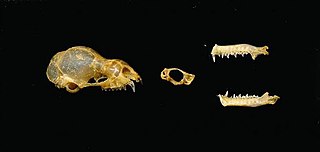
The genus Plecotus consists of the long-eared bats. Many species in the genus have only been described and recognized in recent years.

The long-tongued fruit bat is a species of megabat. It is nectarivorous, feeding on nectar from primarily banana flowers. It is found in several countries in South and Southeast Asia.
Botta's serotine is a species of vesper bat, one of 25 in the genus Eptesicus. It can be found in Afghanistan, Azerbaijan, possibly Djibouti, Egypt, Iran, Iraq, Israel, Jordan, Kazakhstan, Kyrgyzstan, Mongolia, Oman, Pakistan, Saudi Arabia, Syrian Arab Republic, Tajikistan, Turkey, Turkmenistan, Uzbekistan, and Yemen. It is found in rocky areas and temperate desert.
The Gobi big brown bat is a species of vesper bat. It is found in Afghanistan, China, India, Mongolia, Pakistan, and Russia. Russian zoologist Professor Count Nikolay Alekseyevich Bobrinski first described it in 1926, the type specimen coming from the Altai Mountains in the Gobi Desert.
Blanford's bat, also known as the least false-serotine bat, is a species of vesper bat. It can be found in Brunei, Cambodia, Indonesia, Laos, Malaysia, Myanmar and Thailand, where it lives in various different forested habitats. The International Union for Conservation of Nature has assessed its conservation status as being of "least concern".

The desert long-eared bat is a species of vesper bat found in North Africa and the Middle East.

The black-gilded pipistrelle, also known as the bronze sprite, is a species of vesper bat found in China, India, Myanmar, and Nepal.
The lesser long-fingered bat, also known as the black clinging bat or lesser bent-winged bat, is a species of vesper bat in the family Vespertilionidae.

The Himalayan field rat, sometimes known as the white-footed Indo-Chinese rat, is a species of rodent in the family Muridae. It has a wide range, being found in India, Bangladesh, Nepal, Bhutan, China, Myanmar, Laos, Thailand, and Vietnam, with introduced populations in Indonesia (widely), Palau, and the Philippines. A common species, the International Union for Conservation of Nature has assessed its conservation status as being of "least concern".

Blanford's fruit bat is a mountain species of megabat. It is found in several countries in South and Southeast Asia.

The Indian roundleaf bat, also known as the large Ceylon leaf-nosed bat or Kelaart’s leaf‐nosed bat is a species of bat in the family Hipposideridae. It is endemic to the Indian subcontinent, with marginal populations also detected in Southeast Asia. Its natural habitats are subtropical or tropical dry forests and caves. Hipposideros schistaceus is a synonym for the species.

The ashy roundleaf bat is a species of bat in the family Hipposideridae found in India, Indonesia, Laos, Malaysia, Myanmar, Pakistan, Thailand, and Vietnam.

The fulvus roundleaf bat or fulvus leaf-nosed bat is a species of bat in the family Hipposideridae. It is found in Afghanistan, Bangladesh, Cambodia, China, India, Laos, Myanmar, Pakistan, Sri Lanka and Thailand and possibly in Vietnam.
The lenis woolly bat is a species of bat in the family Vespertilionidae. It is found in South and Southeast Asia.
The Japanese long-eared bat is a species of vesper bat endemic to Japan, where it is found in Hokkaido, Honshu and Shikoku. It has distinctive, long ears, hence its Japanese name, the 'rabbit bat'. Formerly included as a subspecies of the European bat Plecotus auritus, genetic studies now indicate Plecotus sacrimontis is a separate species.
The Turkestani long-eared bat, Otonycteris leucophaea, is a species of bat found in Asia. Though it was initially described in 1873 as a species, for many years it was considered synonymous with the desert long-eared bat, Otonycteris hemprichii. Recently, it was recognized as a distinct species once again.
Pipistrellus aladdin, the Turkestan pipistrelle, is a species of bat in the family Vespertilionidae. It is found in Central Asia and Afghanistan. It is assessed as data-deficient by the IUCN.
Plecotus homochrous, commonly called Hodgson's long-eared bat, is a species of bat in the family Vespertilionidae. It is endemic to the Indian subcontinent.
Eptesicus pachyomus is a species of bat in the family Vespertilionidae. It is widespread and found throughout Asia.
Hypsugo alaschanicus, the Alashanian pipistrelle, is a species of bat in the family Vespertilionidae. It is found in China, South Korea, Mongolia, Japan, and Russia.









